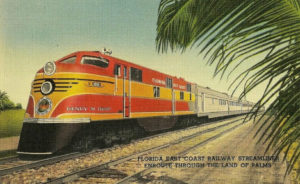A Late In Life Burst of Creativity!
[AdSense-A]
Over the past several columns we have noted that, following the collaboration with our good friend, Professor Gregg Turner, in writing and captioning “The Plant System of Railroads, Steamships and Hotels,” I had what I smilingly refer to as “a late in life burst of creativity.” By now I’m certain (well, at least thinking) that you are all breathlessly waiting to find out what that means. And because I want to allay your anxiety, I’m going to tell you!
After the publication of “Speedway to Sunshine: The Story of the Florida East Coast Railway” in December of 1984, and the re-writing of “The Story of a Pioneer,” the corporate, in-house history of that famous railroad, I did not write another book until the publisher of “Speedway….” suggested, in 2000, that it really was time for the Revised and Enlarged edition of that book to be put together and published. I got to work immediately but the reader should know that I was, at that time, using that machine with a keyboard which required that the user to, at the end of each line, pull the handle to get to the next line. In addition, if I—or anyone using that machine—made an error, he or she had to use some kind of paper eraser to erase said error and then go back for a “do-over.” Now what was the name of that piece of equipment? Oh, right! A typewriter! But with my converting to the computer shortly after the Revised and Enlarged Edition came out, life changed dramatically.
Long story short, I worked on the revised and enlarged edition for almost two years, bringing the story of America’s most exciting railroad up-to-date. As noted several columns ago, when the publisher announced, in October of 2002, that the Revised and Enlarged edition of “Speedway to Sunshine….” would be published in December, the book was—now notice the disclaimer words—the single best selling railroad history book on the internet, with copies going on eBay—even then—for $380 a copy and Myrna asking me why we didn’t keep more copies!
As I wrote previously, not only did all 4,000 hard cover copies sell out in thirteen days but the next edition of 4,000 hard cover copies also sold out, although taking a bit longer than thirteen days. Still, when the soft cover (heavy stock, high gloss) edition was published five years ago “Speedway to Sunshine….” was (disclaimer words!) the single best-selling regional railroad history ever published in America with 11,000 copies sold, and that before the soft-cover edition came out!
I often get asked, “Seth, aren’t you proud of that?” And the answer, and not with false modesty, is that it is not for me to be “proud,” but, rather that the entire state should be proud of the fact that the history of our fabled railroad is, simply put, the number one selling regional railroad history book in the country, and that is almost hard to believe. Now only 366 miles from Bowden Yard, Jacksonville, to Hialeah Yard, Miami, and with one branch line from Ft. Pierce to Lake Okeechobee, which is leased to another railroad, the FEC is the best run, best maintained, best operated, most exciting railroad in the country, with a history which is beyond glorious and which includes the building and later destruction of the Key West Extension along with all of the other achievements of the man whose name is truly legendary in Florida and who is considered the single greatest name in the history of the state, Henry Morrison Flagler. That story is so rich and deep in Florida history and is so entwined with exciting events and accomplishments that it can be easily understood why “Speedway to Sunshine…” is number one.
But what about the Plant System book? In 1899 Reverend William Smyth wrote a biography of Florida’s second most important person, Henry Bradley Plant, whose system of railroads, steamships and hotels, with only the exception of a few of the hotels, was sold by his wife and son after his death in 1899 to the Atlantic Coast Line Railroad. Unlike the FEC, which is a vibrant, living entity, the Plant System was and had been essentially deceased for (at the time our book on that entity was published) 102 years. You can imagine, therefore, what it would take to rebuild the corporate history, as railroads and other companies do not seem to be interested in doing very much to maintain the histories of their predecessors, much less their own.
At any rate, Professor Turner contacted me and asked me to co-author the book with him, which I did, providing the majority of photos and memorabilia, writing the captions, and working with the Professor on the chapters and the research. Published by Garrigues Press in Pennsylvania, that book also has sold out and copies are now on both eBay and amazon.com (when you can find them) for generally more than $100.00.
Book number three was a great success as the first two had been, and it was at that point that Myrna said to me, “you know, with your incredible collection you really should start writing about local history” and a few weeks later, almost as if by magic, the phone rang and the voice on the other end of the line announced himself as being an acquisitions editor with Arcadia Publishing, the largest publisher of local histories in the country. It was 2004 and my life was ready for a dramatic change, which you will learn about in my next column, as we roared out of the starting gate writing local and FEC histories and haven’t stopped yet and don’t plan to, either. We’ll be back shortness and I think you’ll enjoy learning about what happened next. “See you in a few,” and, as always, with all good wishes to all of our and Brad’s readers.
[si-contact-form form=’2′]


